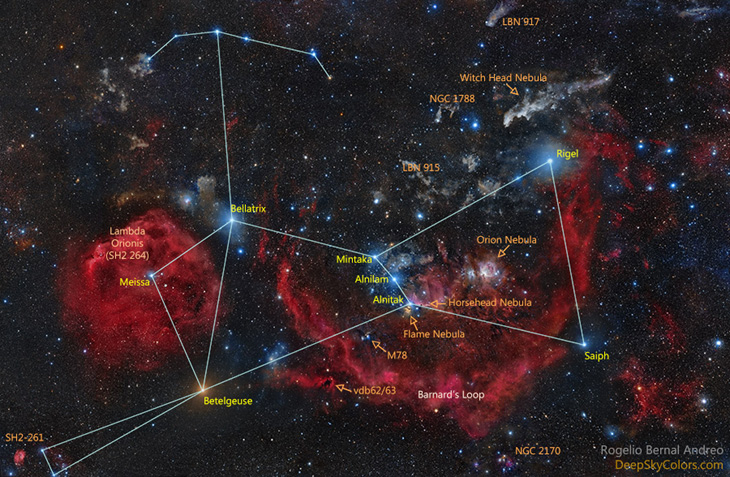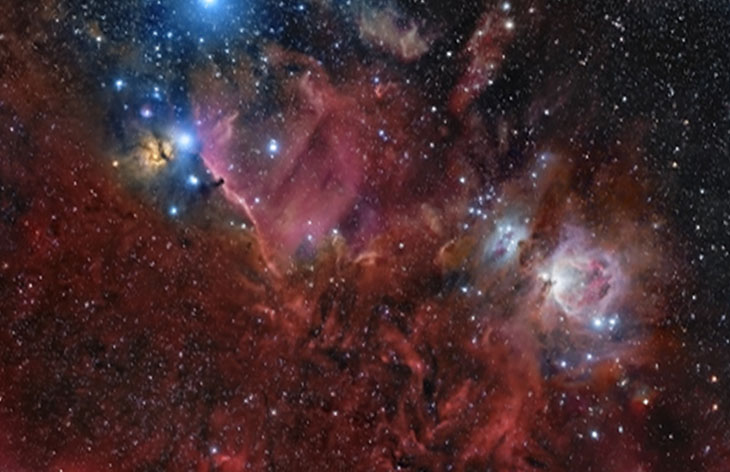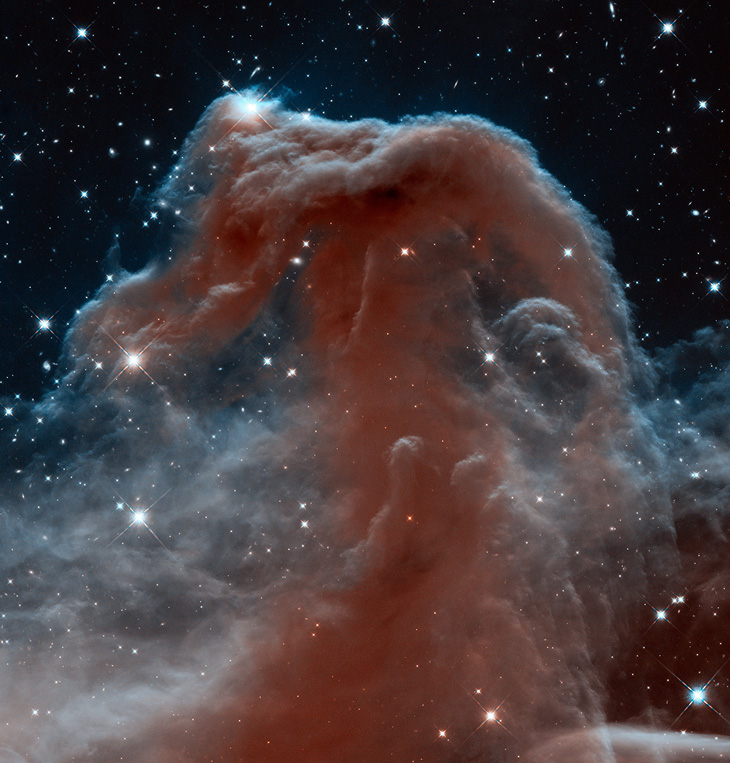Astronomy Picture of the Day is something that should be on your weekly routine, at least – it often features some pretty stunning images. Today’s (or I guess I should say, the image for Monday March 16th, since it’s late and this will probably post early Tuesday morning) is especially cool, and gains additional interest when coupled with a few other details.

This is the version I resized for the blog, but by all means you should go to the original or, for preference, the version you get when you click on that, which is much bigger. On the initial page, the annotations shown above only appear when you hover your mouse over the image, so you can see it without the distracting lines and labels.
 Now, some perspective. You’re not going to see anything like that image above when you go out to look at Orion – what you’re going to see will look much more like the photo at right. Nebulae are faint sky objects, and only a handful are visible without help in the best of viewing conditions. More specifically, most details won’t even show at all without filters designed to select only the narrow bands of emissions that they produce (like, as that page says, hydrogen alpha.) So the APOD image is “shopped,” a composite of visible light and very selective wavelengths captured through long exposures.
Now, some perspective. You’re not going to see anything like that image above when you go out to look at Orion – what you’re going to see will look much more like the photo at right. Nebulae are faint sky objects, and only a handful are visible without help in the best of viewing conditions. More specifically, most details won’t even show at all without filters designed to select only the narrow bands of emissions that they produce (like, as that page says, hydrogen alpha.) So the APOD image is “shopped,” a composite of visible light and very selective wavelengths captured through long exposures.
And the primary issue with long exposures of star fields is that the Earth stubbornly keeps revolving, meaning the stars wheel across the sky, so the only way to get sharp long-exposures is with a system that moves the camera and/or telescope at the same speed, keeping the stars perfectly in frame. On telescopes with an equatorial mount, tracking motors can occasionally be added that keep the scope on your target, but these have to be aligned precisely with celestial north (which is not quite Polaris, the North Star, but fractionally to the side of it.) For anyone lacking such, there are plans available to construct a tracking mount/platform for non-telescope photography, using standard lenses, but there are accuracy issues which may limit how long these can be used before star motion creeps in. It’s a little tricky to describe why and so I’m not going to unless someone asks – for now, blame it on geometry and trying to construct a usable homemade system without custom-engineered parts. If you’re interested, however, do a search for “barn door tracker,” especially the double-arm style, which is much more accurate. I personally have not tackled such a project yet because my access to tools and decent stepping motors is limited.
Without it, however, one is stuck with brief, high ISO shots which cannot capture a hell of a lot. To wit:

This is seven seconds, f5.6, 200mm, ISO 3200 – and there’s still motion in the image, including possibly some tripod shake (the stars should move in a straight line and not a mild ‘U’ shape.) This is almost the exact same orientation as the image right above it (the plain one,) but a tighter framing of the center, focusing on the region of the Orion Nebula and Horsehead Nebula. The brightest star towards the upper left is Alnitak, the ‘leftmost’ belt star, the other two belt stars being out of the frame in a line directly above it. The cluster of stars at center-right are collectively known as Orion’s Dagger, more-or-less appearing as three points to the naked eye, but occasionally visible as being a bit less distinct than just three points, and you can see why – it’s a far cry from three stars. The faintest hint of the Orion Nebula is showing as the flare in this region.
Between and below the two brightest stars to the left lies the Horsehead Nebula, not at all visible above. In fact, even in the big version it shows as just a little dark spot against the pink cloud in the background. I was going to try and guide you to it, but figured it was easier to just present the same image from Rogelio Bernal Andreo, rotated, cropped, and enlarged to match the same perspective as my image above:

There – the Horsehead Nebula is that little dark splotch against the pink cloud at left-center. Now here’s a version imaged by the Hubble Space Telescope, featured in an APOD a few years ago (click there for the bigger version):

It seems kind of inverted, but this is because different wavelengths were captured between the two images. The infra-red filter used for the frame immediately above does not capture any of the hydrogen-alpha wavelength that provides the red colors in the image above it, those same wavelengths being blocked by the dust cloud that appears with such detail here. But this also gives a great impression of the magnification and detail that the Hubble can snag. For giggles, scroll up to zoom back out to a normal view to us on Earth.
And thus the blog title. Even with a decent telescope, even with a tracking platform, there’s no way I’ll ever capture images anything at all like the ones being produced by the professionals. But I’m happy to direct you to the better images, and hopefully provide a little perspective and awe along the way.



















































